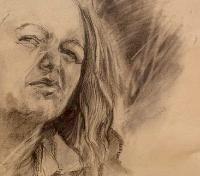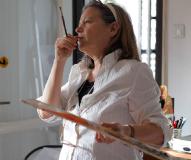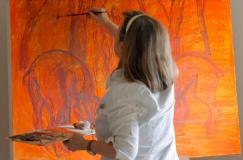 |
|
Mira Kliger graduated from Bezalel Art Academy in Jerusalem. She illustrated for Haaretz daily newspaper and "At" women magazine in Israel.
In London, she built a scuccessful career in advertising and design with a major advertising agency, working for blue-chip national and international clients. She also created and illustrated "Leonardo's Studio" for National Gallery
Concentrating on painting since 2000, Mira has had solo exhibitions in London, Paris and Tel Aviv, As well as group shows in the U.K., Israel and Germany.
All the work shown on this site has been produced from 2002 onwards.


"My works are born of an intimate emotional process - somewhat like revealing oneself. The process of painting is an adventure in form, colour and line which can be created by brush, knife, hand or in fact with any means. A kind of ritual dance - at times gently, at others in anger. In the process, parallel worlds come to be with their own laws of nature, their own stories. There are not always intended to bear pleasure but to leave lingering questions."



'Bible Stories' Mira's 2017 Autumn solo exhibition was at the Gallery du Forez, Paris.
 In her first Paris solo exhibition, the British/Israeli artist Mira Kliger, is exhibiting a selection of life drawings and oil paintings.
Entitled "The Longing Body", the exhibition at the Galerie du Forez in Paris' Marais neighborhood showcases a selection of the artist's drawings of male and female nude, as well as a few oil paintings, which also deal with the subject of longing, of yearning.
Known for her oil portraits and narrative compositions, Kliger is however dedicated to drawing, to the pure "naked" line, impossible to imitate or fake. "Drawing is like the human voice singing without the orchestra accompaniment" says the artist.
In her first Paris solo exhibition, the British/Israeli artist Mira Kliger, is exhibiting a selection of life drawings and oil paintings.
Entitled "The Longing Body", the exhibition at the Galerie du Forez in Paris' Marais neighborhood showcases a selection of the artist's drawings of male and female nude, as well as a few oil paintings, which also deal with the subject of longing, of yearning.
Known for her oil portraits and narrative compositions, Kliger is however dedicated to drawing, to the pure "naked" line, impossible to imitate or fake. "Drawing is like the human voice singing without the orchestra accompaniment" says the artist.
The 15 drawings on show, selected from hundreds, are testament to the power of the line, its amazing ability to create form and depth, to mimic life and to bring out its deeper meanings. Working in charcoal, pencil, conte, and acrylic, Kliger creates life nudes and dream scenes, often on the same canvas.
Wall Street International
 Mira Kliger's studios in Thames Ditton, London and Tel Aviv are permanently populated by friends, family and biblical characters.
Mira's figurative style, reminescent of post-war East European realism, bring her characters to life in a disconcerting fashion. For commissioned portraits, the decisive colours and warm, sympathetic approach means a strong resemblance with the subject, as well as a new, almost surprising interpretation of it.
Mira Kliger's studios in Thames Ditton, London and Tel Aviv are permanently populated by friends, family and biblical characters.
Mira's figurative style, reminescent of post-war East European realism, bring her characters to life in a disconcerting fashion. For commissioned portraits, the decisive colours and warm, sympathetic approach means a strong resemblance with the subject, as well as a new, almost surprising interpretation of it.
With vigorous strokes and classic composition, the Old Testament Tales tell an optimistic story of continuous human suffering and eternal hope. The characters represent us, our parents and our children, as well as Adam, Eve, or Job. They find themselvers in situations parallel to our own, and they survive, they move on, stronger, Life goes on.
Adriana Dredge, University of the Arts London
 Using a palette of subdued local colours with an abundance of underpainting, she does little to glorify the sensuality of her subjects' flesh or intimacy of their bodies.
Using a palette of subdued local colours with an abundance of underpainting, she does little to glorify the sensuality of her subjects' flesh or intimacy of their bodies.
Essentially Kliger wraps the figures skeletons in paint, tooling the pigment as if it were a sculptural medium. Following the contours of predetermined positions and flat lighting, her brush moves like a chopping knife in and out of concave and convex forms, defining the solidity of muscular flesh without relying on linear outlines.
Gil Goldfine, The Jerusalem Post
 Her paintings, titled 'With Modigliani', treat her subjects in Modigliani's poses, themselves quoted from those of the Old Masters. Kliger follows in their footsteps and structures her work geometrically, creating balanced compositions = subject and background.
Her paintings, titled 'With Modigliani', treat her subjects in Modigliani's poses, themselves quoted from those of the Old Masters. Kliger follows in their footsteps and structures her work geometrically, creating balanced compositions = subject and background.
As in the best classical tradition, the style of her painting is detailed. She follows the folds of the body, the creases of the sheets and the tones of the skin. And more, the brushwork is rhythmical and multi-layered. It plays on the emotions true to the subject and atmosphere of the works. Starting with small touches, soft and sensitive and ending with maelstrom of strokes, rich in volume.
Ilan Nachshon, Art critic